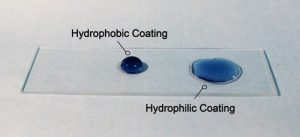Future development prospects of hydrophobic paint

Hydrophobic paint often refer to a class of low surface energy coatings where the static water contact angle θ of the coating on a smooth surface is greater than 90°, whereas superhydrophobic paint are a new type of coating with special surface properties, meaning water contact with a solid coating. The angle is greater than 150° and often means that the water contact angle lag is less than 5°. From 2017 to 2022, the hydrophobic paint market will grow at a compound annual growth rate of 5.5%. In 2017, the market size of the hydrophobic paint will be 10022.5 tons. In 2022, the market size of the hydrophobic paint will reach 13,099 tons. The growth of end-user demand and the excellent performance of hydrophobic paint have driven the development of the hydrophobic paint market. The growth of this market depends mainly on the growth of end-user industries such as automotive, construction, marine, aerospace, medical and electronics.
Due to the growth of the construction industry, the hydrophobic paint used for concrete substrates is expected to reach the highest compound growth rate during the forecast period. Hydrophobic paints are used on concrete to avoid concrete swelling, cracking, scaling, and chipping. These hydrophobic paints protect the concrete surface by increasing the contact angle of the water droplets with the concrete surface.
During the forecast period, the car will become the fastest growing terminal industry in the hydrophobic paint market. The increase in automobile production will drive the automotive industry’s demand for hydrophobic paint.
In 2017, the Asia-Pacific region will occupy the largest share of the hydrophobic paint market, followed by North America. This high growth is due to the increasing demand for automobiles in the region, the increasing aerospace industry’s innovation, and the increasing number of start-up companies in the medical device industry.
Environmental regulations are considered to be a major constraint in the hydrophobic paint coating market. Some manufacturers develop new products in order to be competitive in the market, but at the same time meeting environmental protection regulations will take time and effort.
The types of hydrophobic paint coatings can be subdivided into: polysiloxane-based hydrophobic paint, fluoroalkylsiloxane-based hydrophobic paint, fluoropolymer-based hydrophobic paint, and other types. They are widely used in construction, engineering facilities, automobiles, aviation, and other fields. . Hydrophobic coating process can be subdivided into chemical vapor deposition, microphase separation, sol-gel, electrospinning, and etching. Hydrophobic paint can be subdivided into self-cleaning hydrophobic paint coatings, anti-fouling hydrophobic coatings, anti-icing hydrophobic coatings, anti-bacterial hydrophobic paint coatings, corrosion-resistant hydrophobic paint coatings, etc. according to their properties.

Comments are Closed